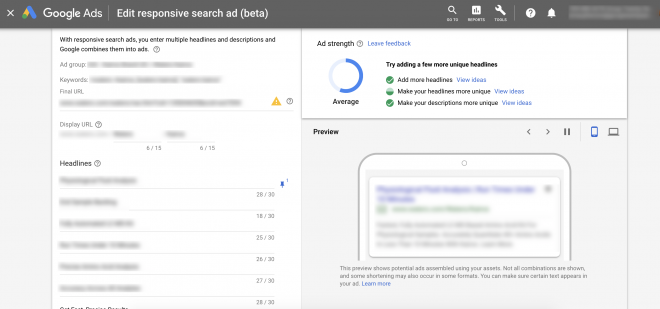When Google rolled out responsive search ads in 2018, they were met with skepticism and resistance by many PPC managers.
Responsive search ads were another instance of Google applying machine learning to the paid search management process — and this made some people nervous.
After all, many managers had had less than great experiences with Google’s other automated tools. And they worried that this tool wouldn’t be any different.
At Group Twenty Seven, we shared these concerns.
These concerns were confirmed when we tested responsive search ads and didn’t get the results we were hoping for.
But a couple of weeks ago, Google invited the Group Twenty Seven team to a customized training event, and responsive search ads were part of the discussion.
And in light of what we learned, we’ve started to reassess this ad type.

What Are Responsive Search Ads?
Before we get into that, let’s back up and review what responsive search ads are.
With responsive search ads, you provide up to 15 headlines and four descriptions.
Google then uses these headlines and descriptions to create your ads.
The more headlines and descriptions you provide, the more options Google has to assemble your messages into relevant ads.
This is in contrast to expanded text ads, where advertisers have to put each ad combination together manually.
Because of this “assembly” process, you need to make sure that at least five of those headlines are distinct and don’t repeat the same or similar phrases.
Because so many combinations are possible, it can be challenging to create responsive ads.
The process is made easier if you slot your headlines and descriptions into different “categories” to minimize duplicate messaging.
For example, we create headlines and descriptions that fit into the following categories to minimize repetition (as suggested by our Google rep):
| Category | Example |
| High query relevance | Buy an espresso machine |
| Product or service | Imported cast iron tea pots |
| Slogans and taglines | Do more with your money |
| Trust | Helping homeowners since 1968 |
| Call to action | Book your adventure |
| Brand | ABCelectronics.com |
| Inventory and selection | 100s of items to choose from |
| Shipping and returns | Free shipping |
| Support and customer service | 24/7 online support |
| Warranties and guarantees | Satisfaction or your money back |
| Pricing and fees | Starting at $399 |
| Incentives and discounts | Get 25% off |
Note that responsive search ads are still in beta and aren’t available in every Google Ads account.
Potential Benefits of Responsive Search Ads
Responsive search ads have the potential of performing better than your typical expanded text ad for a few reasons:
- More ad combinations: Because Google puts these ads together automatically, it can create any number of combinations — many more than if you had to put together each combination yourself.
- Real time matching: Google closely matches ad text to search queries in real time.
- Greater ad relevance: Because of this real time matching, ad relevance should be higher for every single search.
How to Evaluate the Performance of Responsive Search Ads
As I mentioned, when we first started testing responsive search ads we were disappointed in the results.
Specifically, we didn’t like our click through rates (CTRs) for these ads. They were much too low when compared to expanded text ads.
Eventually, we realized that this low CTR number was misleading. Responsive search ads impression more often than normal text ads. And this higher rate of “impressioning” lowers the CTR.
But if we couldn’t evaluate responsive search ad performance by comparing it to expanded text ad performance, what could we do?
With the help of the Google training, we came up with three new ways of evaluating responsive search ads:
1. Ad strength report
Google rolled out the ad strength report in response to complaints about lack of insight into responsive search ad performance. (Clearly, we weren’t the only ones struggling to evaluate these ads!)
The ad strength report measures relevance, quantity and diversity of the ad copy in responsive search ads. It rates the ad from “Poor” to “Excellent” and provides suggestions for improvement.

Your ads might score low. If they do, keep working to improve them.
Whatever you do, don’t be tempted to stop using them altogether. Having low scoring responsive search ads is still better than having no responsive search ads at all.
2. Combination report
Another way to evaluate responsive search ads is to look at the combination report on the ads & extensions page.
This report shows the performance metrics for each responsive search ad. You can see which ad combinations were shown most often for different search queries.
As an added bonus, you can use this report to see what’s working (and not) for responsive search ads — and apply those lessons to your expanded text ads.
3. Overall ad group performance
As I mentioned, if you measure the performance of responsive search ads against the performance of your existing text ads, you’ll be disappointed.
The goal isn’t for responsive search ads to replace your text ads. Instead, look at them as a complement to your text ads.
In fact, Google also makes this point. It indicates that responsive search ads are designed to drive incremental volume of up to 10%.
So think of responsive search ads as an enhancement to your current account, not a revolution!
Is It Time to Give Responsive Search Ads Another Chance?
If you’ve given up on responsive search ads, it might be time to give them another try.
Adjust your expectations. And don’t get caught up in CTR numbers.
You may find they give your campaigns a welcome lift.






